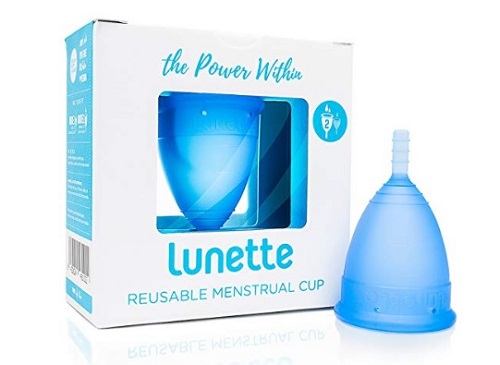If talk about menstruation (periods) or blood makes you squeamish, you might not want to read this post.
Seven months and eight periods ago, I traded in my tampons for a menstrual cup. I’m so glad I made the switch. Note: This post contains affiliate links, each marked with an asterisk (*).
I had two motivations for doing this:
- Cost: My Lunette menstrual cup (Model 2)* cost $28.99 on Amazon. It will easily pay for itself in less than a year, and may have already.
- Environment: There’s no trash when you use a menstrual cup, just empty, clean, and re-use. Tampons, pads, applicators, and wrappers, on the other hand, pile up in landfills.
Day 1: It Got Stuck
It didn’t get stuck-stuck, but it took a bit to figure out how to slide the cup out of my body. Getting the cup in to my body was easy – squeeze one side in so the circle at the top looks like a “C,†and slide it in. It re-expands back to its circular shape and the little holes near the top create a suction against your skin. You have to break this seal to get it back out, which is challenging when you have tiny hands and short fingers like me. The first time I tried to get it out after wearing it a few hours (you can wear it up to 12 hours) was a complete fail. I got it out that evening, but it took 20 minutes to figure it out.
Leaks Happen – But Not Often
Before switching to a menstrual cup, I dealt with leaks all the time. I have designated underwear for this week. Doesn’t everyone?
I have way fewer leaks with the menstrual cup. I’ve had two leaks because I didn’t quite get the cup into place, and I think I overflowed it once. I just wear black underwear and that seems to be enough. I don’t need to wear a pantyliner or anything for backup.

My Own Horror Movie
Tampons and pads work by absorbing your blood. You can’t tell how much fluid they’re actually holding. Cups are the opposite. It’s just a silicon cup that catches your blood. When you empty your cup when you’re in the shower or sitting on the toilet, it looks like a horror movie. You know exactly how much you’re bleeding.
Thank goodness men don’t get periods. If teenage boys used menstrual cups, they’d be throwing blood at each other in high school bathrooms.
What about Public Bathrooms?
When you empty your cup, you’re supposed to at least rinse it before putting it back in. I’m lucky where I work only has single-user bathrooms so I can easily rinse my cup in the sink.
With multi-user bathrooms, that’s not the case. Thankfully, I’ve only had to deal with this once. I emptied my cup, wiped it out with toilet paper (and dripped blood on my shoe), put it back in, and wiped the blood off my fingers before exiting the stall. It wasn’t a big deal.
No Rogue Strings (Yay!)
Tampon users know this one: sometimes your string “goes rogue†and pulls in the opposite direction from where it should be. And it hurts. And there’s no discreet way to fix it. You have to reach into your underwear and put it back in place.
When this happened to me, it was usually when I was out running, far away from a bathroom. It happened so frequently, I switched from tampons to “period panties†when I was running. With the cup, there’s no string to worry about.
Equally convenient, I don’t have to worry about having a visible string when I go swimming – which is currently twice a week. (Yes, there’s a true story from my gymnastics days when I was competing in a black leotard with a visible white string!) When I’m at the pool, I always worry that I didn’t put my cup in properly and it will leak. I have a fear of finishing a lap and being confronted by a lifeguard who tells me I’m bleeding in the pool. So far, that has not been an issue at all.
Helps with Dysphoria
Using a menstrual cup* helps with the dysphoria I have about being non-binary and trapped in a female body. When I was using tampons, I had to change it five times a day or more on my heaviest day. That meant I had to have tampons with me, carry them through the office on my way to the bathroom, dealing with the string, and being confronted with my period each time I changed my tampon. Cups are designed to be worn for up to 12 hours, so I only have to deal with it twice a day, three times on my heaviest day. Otherwise, I can “set it and forget it.â€
Well, except for the cramps part.